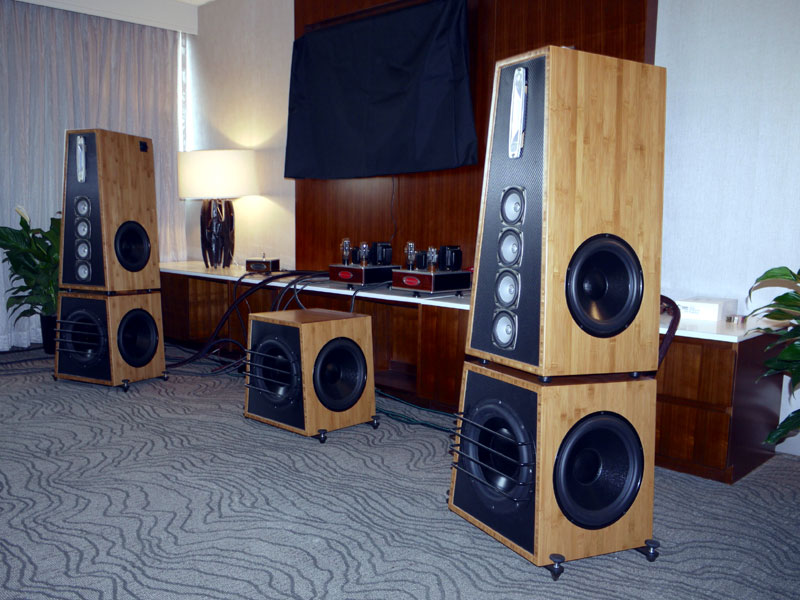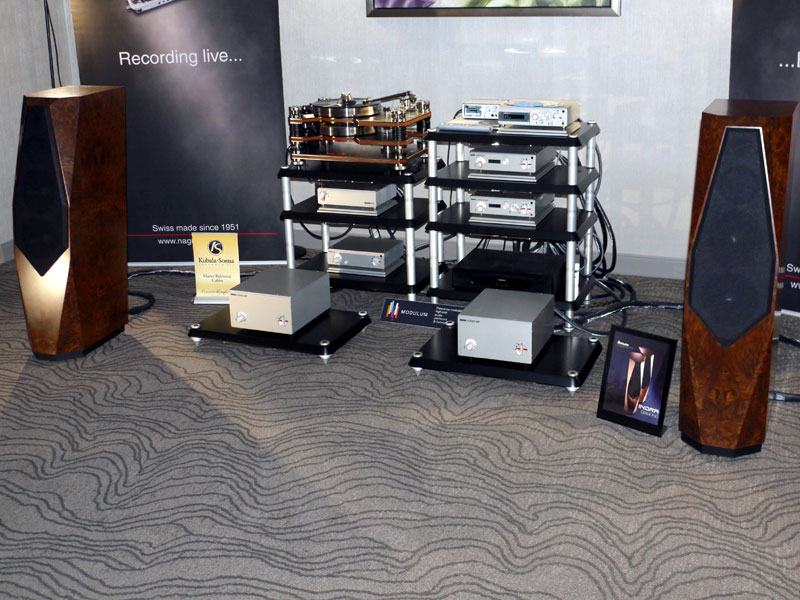Rocky Mountain Audio Fest 2016 • TABlog
s any exhibitor will tell you, the room’s the key. All else aside, regardless of the equipment or the exhibitor’s ambition, it’s the room that sets the upper limit of attainable performance. The loftiest musical intentions can easily be laid low by issues as mundane as room dimensions, structure, rattling ceiling tiles or light fittings, unfortunate (often immobile) furniture or doors that insist on being sited in the most inconvenient places. No surprise, then, that most exhibitors cling to their existing rooms year on year with all the fervor of a shipwrecked sailor gripping a lifejacket. Any new show or new room instills a deeply felt sense of trepidation. So imagine the barely suppressed air of consternation, laced with a heavy dose of resignation, that permeated a setup day in a half-open, half-remodeled Marriott Denver Tech Center. Every room was new, while most of the services and facilities were running at half capacity or half pace. Pity the organizers, faced with a rising tide of issues ranging from accommodation through access, facilities through recalcitrant AC. Rocky Mountain Audio Fest's (RMAF) usually impeccable logistics and shipping inexplicably threw a shoe, and setup, which is generally considered a challenge, suddenly became a struggle. That the show happened at all is a testament to the bloody-minded perseverance of RMAF and its exhibitors alike; that it was as successful as it turned out to be was little short of miraculous, a monument to the Dunkirk spirit that so often comes to the rescue of the audio industry.
The VTL/Wilson experience is a case in point. So often in years past a beacon of sonic and musical excellence, the VTL room has become a regular recipient of Best Sound of Show awards, on occasion rising to such a level as to challenge the best sound I’ve ever experienced at any show. Except that this year their familiar room (with its familiar issues) had disappeared into the ravenous maw of the remodel, and they found themselves in a smaller and far less promising space. To compound matters, the Wilson speakers disappeared into one of the logistical black holes, only reappearing late on the setup day, while Peter McGrath (Wilson’s veteran setup man, detailed to deal with the tricky business of optimizing a brand-new speaker in a brand-new room, but unavoidably detained by Hurricane Matthew) didn’t show up until midnight on Friday, 14 hours after the show opened. That the performance in this room proved to be one of the most musically engaging and impressive at the show stands testimony to the ability, experience, planning and can-do attitude of those involved. A detailed survey of the room carried out months in advance definitely paid off, providing preliminary speaker positioning and orientation, allowing the rest of the system and cabling to be installed and warmed up, even before the speakers finally appeared. The turntable and cartridge had been carefully tuned before the show and packed to preserve the settings and alignment, leaving only final optimization once the system was up and running. When the speakers finally showed up, it was time for Wilson’s newest recruit, Bill Pugh, to step up to the plate -- there’s nothing quite like being thrown in at the deep end. Under the circumstances, the sound unveiled at 10:00 the following morning was little short of amazing, while steady improvement as the system settled throughout the show made a Sunday-afternoon session of glass-CD replay, presented by Audiotechnique’s Lincoln Cheng, truly memorable. The system consisted of a dCS Rossini digital player ($28,499) complete with obligatory clock ($7499), VTL TL-6.5 Series II line stage ($15,000) and S-400 Series II power amp ($33,500), driving the Wilson Yvettes ($25,500/pair) via a complete loom of Nordost’s Odin 2 (starting at $10,999), while support was provided by an HRS SXR rack and platforms ($22,855), with minimal use of Tube Traps and RPG Variscreens to help tame the room. The end result had all the scale and dynamic authority we’ve come to expect from VTL/Wilson pairings, combined with deft musical subtlety and spatial coherence, especially once those glass CDs were unleashed on a largely unsuspecting audience. But throwing in the analog front-end really raised this system’s game. The Brinkmann Spyder, 10.5 tonearm and RoNT power supply ($21,680) were paired with a Lyra Etna SL cartridge ($9995) and a VTL TP-6.5 phono stage ($15,000) specially equipped with custom silver step-up transformers to match the cartridge’s low output, all to stunning effect. Record replay brought a fluidity and articulation to the system, an unimpeded sense of flow, unforced sense of separation and placement, texture and intimacy to the performances that made for captivating listening. But this wasn’t just about grace and finesse, as Intervention Records’ fabulous Joe Jackson re-releases demonstrated, with deep, powerful and tuneful bass underpinning all the emotional range required to make every last sardonic twist of Big Joe’s lyrics hit home. Fools in love? There were plenty of those here after experiencing what Wilson’s latest baby can deliver.
The unflappable Gordon Rankin presided over the now-familiar pairing of his Wavelength Audio streaming DACs and amplification with the Vaughn Plasma Signature loudspeakers ($20,000/pair plus $3000 per subwoofer), a setup that impressed us last year. This time around the speakers have improved considerably in terms of fit, finish and appearance, while a change in the Fostex driver delivering the wide-open dipole midrange has resulted in even better integration with the DuKane plasma tweeter. Each speaker sat atop one of the powered subwoofers, with a third used between the two towers to deliver extra bandwidth. With no fewer than 27 drivers in use, the clarity, precision and transparency of this system were little short of remarkable, while once again the Wavelength electronics demonstrated that file replay sources (in this case a MacBook Pro) can compete with physical media if you take enough care. In this case Crimson ($4000) or Cosecant ($9000) DACs were teamed with the new Europa preamp ($7500) and Napoleon AG power amps ($35,000/pair), laced together with a range of AudioQuest’s Diamond, Sky and Redwood cables. The results were as calm, open and relaxed as the beatific grin on the countenance of the man at the controls, and this system was one banker that definitely delivered, the Wavelength/Vaughn pairing going from strength to strength, year on year.
Nagra’s latest Classic-series products have been garnering serious plaudits from around the world, and on this showing it’s not hard to understand why. A change of designer has breathed new life into this respected but otherwise moribund brand, combining impressive sonic and musical performance with the company’s much-loved (if occasionally eclectic) casework. The results here were simply excellent, with the lucid resolution, spatial organization and agile dynamics of the Classic Amp Mono ($16,000 each), Classic Preamp ($17,000), Classic DAC ($14,000), CDC ($16,000), VPS phono stage ($7650), MPS power supply ($6500) and Seven portable digital recorder ($4800) playing to the strengths of the “back from the dead” Avalon Indra loudspeakers ($34,995/pair). Those now rarely seen, sloping, facetted cabinets certainly served to remind us of just what we’ve been missing, and this was one of the most articulate and communicative systems on show. The record player was supplied by Kronos (the $35,000 Pro, complete with $8500 Black Beauty tonearm and a €3390 EMT S75, a cartridge that looks like a serious bargain in this company), and all cabling was Kubala Sosna Master Reference (starting at $6000 for a pair of interconnects and $1800 for a power cord). The system was supported on a Modulum rack ($1995/level), and I have no doubt that this coherent attention to the details of system infrastructure played a significant part in allowing the Nagras, Kronos and Avalon products to show their worth.
Another notably successful pairing in the seldom-seen category was to be found in the Zanden room, where the company teamed its mid-level electronics (Model 120 phono stage, $7500; Model 3100 line stage, $12,500; and Model 6000 integrated amp, used as a power amp only, $22,000) with a pair of Tidal’s intriguing Piano Diacera loudspeakers ($42,900 in their sumptuous real-wood veneer, a mere $33,900 in basic finish). Front-ends were a rarely used Aurender A10 server/streamer ($5500) and a Kuzma Stabi M, 4Point tonearm and CAR-40 cartridge ($28,820), the latter in heavy rotation with a selection of vinyl, new and old, the irrepressible Eric Pheils busily demonstrating the benefits of switchable replay EQ to anybody who would listen. The sound of this system was redolent with the organic warmth and musical flow that are so characteristic of Zanden’s electronics, a canny pairing with the unforced neutrality, transparency and precision of both the Kuzma front-end and the Tidal speakers making for a beautifully balanced performance. Ella’s phrasing was especially impressive, while her articulation and control of rhythm and tempo on Clap Hands . . . were breathtaking. Meanwhile Milt Jackson’s Bag’s Bag clearly showed the musical upside of the Columbia EQ curve, yet more proof that the RIAA fundamentalists are more impressed by hearsay than the evidence of their own ears. However, one of the more interesting aspects of this
system was to be found in the various ancillaries employed: Zanden cables (I didn’t
even know they made them), ZVA-1 vibration-absorbent footers ($50 each) and ZPM-1 record
mat ($300) were mixed with HRS M3X platforms under the turntable and amplifier and
Stillpoints under the phono and line stages as well as the speakers. The lossy footers and
record mat are laminated from Hanenite gel and latex, the isolation feet adding a layer of
harder urethane in order to maintain their shape. Such soft interfaces are currently
unfashionable, but there’s no arguing with the vivid tonal palette and engaging
musical vitality of this system, which certainly seemed to benefit from its eclectic,
mix-and-match support strategy, debunking a different kind of dogma. |




